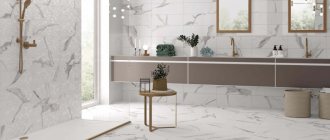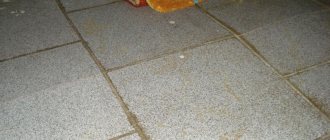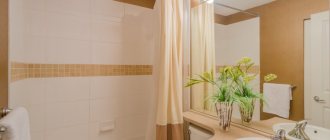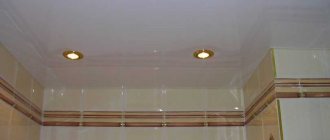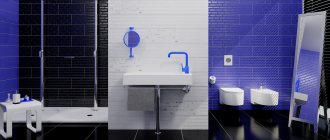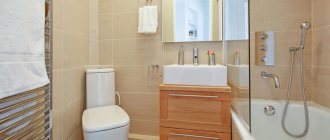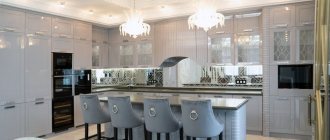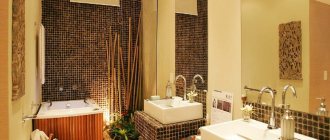Selection of finishing materials for the bathroom
The larger the bathroom space, the fewer restrictions there are in the selection of materials. In a large space, it is appropriate to use dark shades, without fear that they will visually narrow the room.
A design is possible in which dark and light colors are combined with each other: the top of the room can be decorated in pastel colors, and the bottom in dark or bright colors, or colors that imitate wood.
- Before purchasing, you need to calculate the required amount of material. To do this, the main thing is to measure the bathroom around the perimeter.
- It is necessary to measure the length and width of the room and multiply these indicators by each other.
- You also need to find out the length and width of the future tile.
- To find out the required amount of material, you need to divide the previously obtained figure by the length and width of the tile. These calculations will work for the floor.
To calculate the number of tiles on the walls, you need to find out their area, excluding the door, add up the calculated data and divide by the length and width of the tile.
Marble decor in the bathroom
Any of the shades of marble-effect tiles is magnificent in a bathroom interior, but more often they give preference to the white and light gray version with sparse veins, as in the photo.
Imitation of natural marble is also welcome in other decor:
- countertops and window sills;
- plumbing;
- niches and shelves;
- stands and stands;
- oriental washing bowls;
- cladding a pedestal for a bathtub, jacuzzi or mini-pool.
Tabletops and counters made of acrylic “stone” with natural chips in the same color as marble tiles – the splendor of a harmonious interior.
Designers appreciate matte marble-like tiles because wet feet do not slip on them. In addition, it has an amazing ability - adaptation to any stylistic decision.
With imitation of natural stone, any interior looks noble and luxurious. In a classic bathroom, the wall and floor cladding looks just as beautiful as in combined modern or art deco bathrooms.
Any stone looks cold and inhospitable, but this does not apply to marble. Tile cladding made from synthetic analogues of crystalline quartzite looks welcoming and cozy, even if it is an elite bathroom with Empire or Baroque figurines.
More examples are in the photo of marble-effect tiles for the bathroom in interiors of different styles.
Marble tile colors
Owners of small bathrooms need to be very careful when choosing tiles. To visually expand the space, you need to think about the correct selection of the color palette and texture of the material.
- Pastel colors visually enlarge the room, creating the effect of spaciousness.
- It is desirable that the tiles be in light, cream, beige tones.
- To make the bathroom comfortable and warm, you need to pay attention to soft pink or light orange tones, and if you want the space to feel cool, you can opt for turquoise, mint, and sky blue shades.
A good option would be to decorate the walls and floor in the same color scheme. In this case, the room will visually look more spacious. You should not create a contrast between the walls and the floor: this will make the room visually look smaller.
You can use up to five different shades in one room, but they all must be combined with each other.
Methods for laying marble tiles in the bathroom
For ease of transportation and installation, layers of marble megalith are cut into squares or rectangles of different formats. This is very convenient when you want to choose a specific bathroom design with marble tiles.
Stone tiles are unpredictable when they are cut. In one place the correct angle of 90° is obtained, in another place chips or peelings form. You have to grind down all 4 corners and adjust the entire batch. But even for such 8-sided squares, they came up with their own way of laying them - making small inserts of a contrasting color between the large squares.
Classic marble floors - laying in a checkerboard pattern. Today it is simply a tribute to fashion or an echo of the traditions of the Middle Ages. During the time of Gothic architecture, a lot of black and white marble was quarried in Italy. It was alternated in checkered patterns to visually fill the space of Gothic cathedrals.
Today, such a layout can be found in a combined bathroom, hallway or kitchen - tiles of contrasting colors are alternated. You can experiment with color and contrast combinations of marble tiles in the bathroom, using not only the gothic black and white tandem.
For rectangular fragments, “brick” installation is suitable. The seams in it alternate in a certain way, forming horizontal rows. Traditionally, this method is more often seen in wall cladding. But this installation method is also suitable for the floor, where the entire room is “lined” with the same porcelain stoneware.
Helpful advice! Use a mosaic layout with a colored rosette in the center and linear frames towards the edges of the room. Sometimes large slabs or a “path” of natural marble are alternated in the center (so as not to cut), complemented by plain tiles or porcelain stoneware.
Tile materials are also good because you can alternate squares or rectangles of different shapes and colors. The result is an interesting ornament or chaotic arrangement in a pleasant color scheme. Traditional methods include herringbone and steps.
For seamless installation, the most expensive material is used - there is a lot of waste when cutting it. The seams are almost invisible, but the large squares differ in the direction of the veining pattern.
Relief and dimensions of marble tiles
A small room can be decorated with materials with a glossy surface. You need to think about good lighting, then the bathroom will look chic at any time.
In addition to glossy materials, you can use semi-gloss rough marble. It is better if the tiles on the floor are in the same color scheme as the wall decoration. Due to the roughness of the material, the tiles become less slippery, which reduces the possibility of falling.
A solid material with a long service life is porcelain stoneware. Porcelain stoneware tiles are the most wear-resistant.
A large selection of materials allows you to choose the most optimal for a certain type of room. It is better to decorate a small bathroom with small tiles. Large tiles will visually reduce the space.
In case of contamination, cleaning small tiles is a little more difficult than standard tiles. On white or beige tiles, dirt, dust or stains will be less noticeable than on dark walls or floors. Small chips on light-colored tiles can be easily painted over with clear varnish, but on a dark surface this will be too noticeable.
Interior styles (instructions for combining tiles)
For classics, decorating a bathroom with marble tiles is considered the best option. You can tile not only the walls, but also the floor and ceiling.
Marble is well suited for finishing horizontal surfaces.
- Minimalism involves the use of natural stone in white, light gray or black.
- For a country-style room, a wood-like marble finish is suitable. It is advisable to choose red-brown or light-colored marble, similar to wood.
- When choosing a retro style for a bathroom, you need to take into account that marble finishing will not always look appropriate. Marble is suitable for a room in the style of the 30s. It would be appropriate to use black and white stone for the flooring. It is better if the floor is decorated in a checkerboard pattern.
- For an antique style, white or light cream shades with golden cracks are suitable. This type of marble is suitable for wall decoration. The floor decoration should be combined with the decoration of the walls, that is, have a golden tint. Columns and stucco work perfectly with marble. Decorative elements should include gold elements.
- For Art Deco, bright, rich or dark colors are suitable. The ideal option is a completely black finish for the entire bathroom, plus crystal.
- Baroque assumes the presence of crystal and also gold elements. Light beige, cream or light pink material is suitable here. The floor can be finished in black. Marble goes well with crystal and lamps.
- Art Nouveau involves finishing with natural stone in pastel colors. Light gray, beige and white tones are appropriate. Do not clutter the interior with unnecessary details.
- Eco-style involves the use of only natural materials. Therefore, marble should imitate wood, and it is better to decorate the room with real plants and wood trim.
Marble or tile analogue: which is better?
Some subtypes of natural marble are susceptible to solvents and acids - “etched” spots appear. Acrylic, polymer and porcelain stoneware “marble” are less susceptible to negative influences.
Note!
- Italian tiles for floors and walls: photos of beautiful tile designs in the bathroom and kitchen. Choosing tile color, style and size
Do-it-yourself tile shower step by step: instructions, algorithm of actions, dimensions, layout diagrams, photo of a shower with and without a tray
- Mosaic from broken tiles: step-by-step instructions on how to lay it out with your own hands (140 photo ideas)
Helpful information! Natural marble tiles “sound” a little when the dosimeter is turned on. Therefore, it is often excluded from lists of recommended linings for those who spend a lot of time in the pool. This is another reason why wood and marble tiles are better than natural materials.
Natural marble is susceptible to scratches - this is a hassle with polishing and waxing, updating protective coatings made of hard polymer. It absorbs and retains moisture. In a room without airing or ventilation, putrefactive microflora grows in its cracks and scratches.
And the top layer of inexpensive ceramics and tiles gradually wears off under shoes. For this reason, in any hall of a museum or palace exhibition, guides force tourists to change their shoes into soft slippers.
Note! Not every tile cutter will take a solid porcelain stoneware base with a marble pattern. Therefore, it is important to clarify the type of tile. Experts recommend contacting companies that have a waterjet cutting machine. Many construction hypermarkets have similar equipment.
Artificial materials are much easier to cut, prick or pinch off when the shape of the slabs needs to be changed during installation. Tiles with marble stains look no worse than other analogues of natural stone. Even a specialist cannot distinguish marble-effect tiles in a bathroom from the natural “source” from a photo.
Note!
Mosaic for the bathroom: TOP-150 photos of new designs, as well as modern ideas for combining mosaic tiles
Do-it-yourself water heated floor under tiles step by step: installation instructions with photos and descriptions, installation and connection
- Quartz vinyl floor tiles - what is it? Application features, advantages, disadvantages, choice, manufacturers, photos
Distinctive features of marble finishing
Not every owner of a house or apartment can decorate a bathroom with marble. Marble is considered an expensive material, so only lovers of luxury can afford to decorate it.
The most valuable material is the one with small veins. The color scheme has a wide range of shades, including coal black, emerald, red-brown, steel gray, light pink tones.
Advantages of marble tiles
- High strength material. In terms of hardness, it can only be compared with granite. In addition, it has increased resistance to mechanical damage.
- Long service life. The natural feature of marble is that over the years it does not flake or crumble.
- Increased wear resistance. It is very difficult to scratch a marble surface.
- Useful natural properties. Marble prevents the growth of bacteria and fungi, as it is considered a natural antiseptic.
- Environmentally friendly material. Due to its beneficial natural properties, the material is not dangerous for people or animals.
Advantages and disadvantages of marble tiles for the bathroom
When discussing the pros and cons of any coating in a room with high humidity, it is important to imagine it in operation. A beautifully decorated room can pose a risk of injury if the floor covering is chosen incorrectly.
Note!
Epoxy grout for tiles: pros and cons, scope, varieties, how to work with it (instructions + photos)
- Do-it-yourself tile shower tray step by step: instructions, dimensions, design, installation of communications, types of structures, photos
- White tiles in the bathroom: 170 photos of the best ideas and new tile designs. Layout schemes and beautiful combinations
Let’s imagine the elite interior of a spacious bathroom with imported marble-like tiles from Kerama Marazzi, where you get wet feet after a shower. What if it's slippery or cold there? Quite possible. But this is why they produce matte porcelain tiles with an anti-slip coating to prevent them from falling.
Excellent properties of ceramic marble tiles for the bathroom:
- splendid aesthetics and presentable design;
- a large selection of patterns and color variations - from white stone to black;
- the convenience of laying the floor of a small bathroom with marble tiles;
- increased wear resistance of tile materials;
- resistance to mechanical stress, changes in humidity and temperature;
- high level of noise absorption, fire resistance and tightness (with proper installation);
- practicality in care (easy to wash and clean);
- It’s worth buying any marble-effect tiles for the bathroom – they have excellent compatibility with other facing materials;
- excellent adaptability to any type of heating, including warm cable for underfloor heating.
Each facing material has its own disadvantages, including all types of marbled tiles. Quartz stone is known for its high cost and seamless installation technology, but it is not as cold as other variations. The “warm floor” system is a solution to problems with heating a cold stone surface in winter.
Softer and less expensive facing materials are suitable for walls, including ceramic marble tiles. Lithoceramics is an excellent material for DIY wall cladding.
